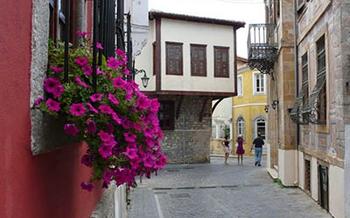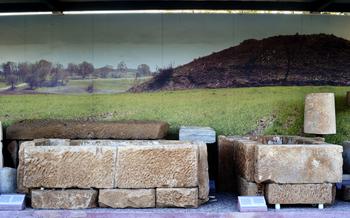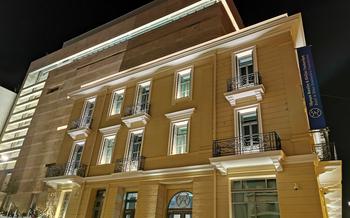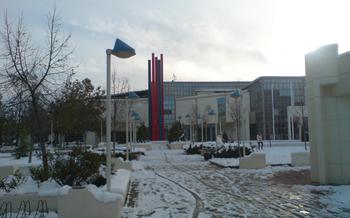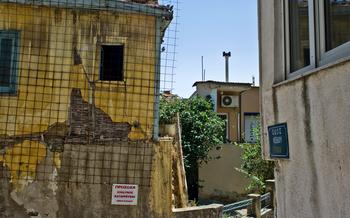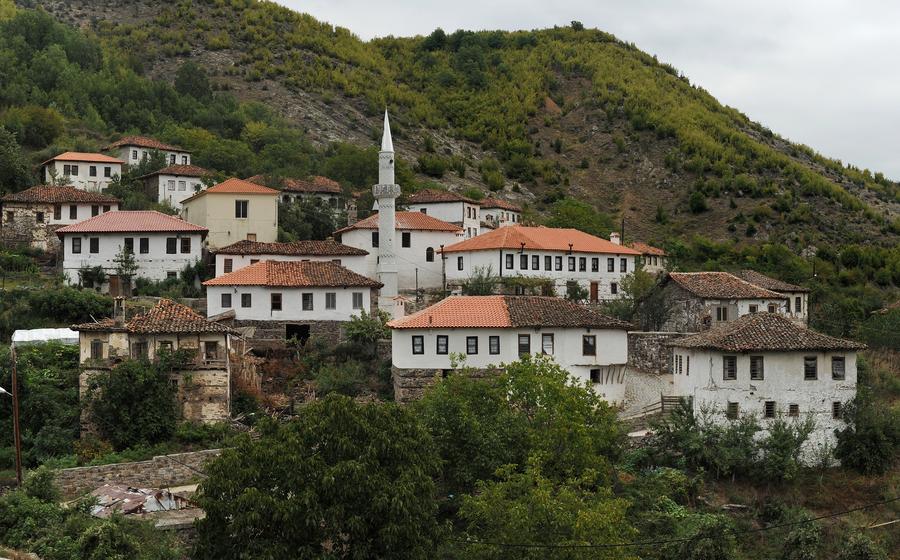
The Cultural Route of the Tobacco Warehouses
- History of Xanthi's Tobacco Warehouses
- Cultural Significance of the Warehouses
- The Cultural Route of the Tobacco Warehouses
- Visiting the Warehouses
- Warehouse 1
- Warehouse 2
- Warehouse 3
- Warehouse 4: A Creative Hub in the Heart of Xanthi
- The Tobacco Museum
- The Municipal Gallery of Xanthi
- The Old Town of Xanthi
- The Nestos River and the Xanthi Forest
- Local Cuisine and Products
- Festivals and Events in Xanthi
- Insider Tip: Hidden Gems of Xanthi
History of Xanthi's Tobacco Warehouses
Xanthi, a city in northeastern Greece, was once a major center of tobacco production and trade. The city's tobacco industry flourished in the 19th and 20th centuries, and the construction of large tobacco warehouses became a symbol of Xanthi's economic success.
The warehouses were designed to store and process the large quantities of tobacco that were produced in the surrounding countryside. They were typically built with thick stone walls to protect the tobacco from the elements, and they had large windows to allow for ventilation. The warehouses were also equipped with machinery for sorting, grading, and packing the tobacco.
The tobacco industry played a vital role in the development of Xanthi. It provided employment for thousands of people and generated significant revenue for the city. The warehouses became iconic landmarks of Xanthi, and they helped to shape the city's identity.
However, the tobacco industry in Xanthi declined in the late 20th century due to a number of factors, including competition from other tobacco-producing countries and changes in smoking habits. The warehouses were eventually abandoned, and they fell into disrepair.
In recent years, there has been a growing effort to preserve and revitalize the tobacco warehouses of Xanthi. Several of the warehouses have been restored and converted into cultural venues, museums, and creative spaces. The warehouses have become a symbol of Xanthi's cultural heritage, and they are now a popular tourist destination.
Cultural Significance of the Warehouses
The tobacco warehouses of Xanthi hold immense cultural significance, transcending their role as mere industrial structures. They embody the city's rich heritage, deeply intertwined with the cultivation and processing of tobacco. These warehouses served as the epicenters of Xanthi's tobacco industry, shaping the city's economy, society, and identity.
Throughout the decades, the warehouses witnessed the bustling activities of tobacco merchants, farmers, and workers, who toiled tirelessly to produce and export the region's finest tobacco. The warehouses became repositories of memories, stories, and traditions passed down through generations of Xanthians. They stand as testaments to the city's resilience, ingenuity, and entrepreneurial spirit.
Beyond their economic importance, the tobacco warehouses played a crucial role in shaping Xanthi's cultural identity. They fostered a sense of community and solidarity among the city's inhabitants, who shared a common bond through their involvement in the tobacco trade. The warehouses became symbols of Xanthi's prosperity and progress, attracting visitors and merchants from across the region and beyond.
Today, as the tobacco industry has declined, the warehouses have taken on a new significance. They have become symbols of Xanthi's cultural heritage, reminders of a bygone era that left an indelible mark on the city's identity. The warehouses have been carefully preserved and restored, repurposed as cultural venues, museums, and creative spaces. They now serve as platforms for exhibitions, performances, workshops, and other cultural events, ensuring that the legacy of Xanthi's tobacco industry continues to live on.
The Cultural Route of the Tobacco Warehouses
The Cultural Route of the Tobacco Warehouses is a unique initiative that showcases Xanthi's rich tobacco heritage and its transformation into a vibrant cultural destination. The route encompasses four historic tobacco warehouses that have been carefully restored and repurposed into cultural venues, museums, and creative spaces.
The concept behind the cultural route is to provide visitors with an immersive experience of Xanthi's tobacco past and its present-day cultural scene. By exploring the warehouses, visitors can learn about the history of tobacco cultivation and processing, admire the impressive architecture of these industrial buildings, and experience the vibrant cultural events and exhibitions that take place within their walls.
The warehouses included in the route are Warehouse 1, Warehouse 2, Warehouse 3, and Warehouse Each warehouse has its own unique history and architectural features, but they are all united by their common tobacco heritage. Warehouse 1 now serves as a cultural venue for exhibitions, concerts, and other events. Warehouse 2 has been transformed into a museum dedicated to the history of Xanthi's tobacco industry. Warehouse 3 is a multi-purpose venue that hosts concerts, theater performances, and other events. Warehouse 4 is a creative hub that provides workshops, studios, and other spaces for artists and entrepreneurs.
The Cultural Route of the Tobacco Warehouses is a significant achievement for Xanthi, as it has helped to revitalize the city's historic center and attract visitors from around the world. The route is a testament to Xanthi's commitment to preserving its cultural heritage while embracing its future as a dynamic cultural destination.
Visiting the Warehouses
Xanthi is conveniently connected to major cities in Greece by road and rail. The city also has a small airport, with flights from Athens and Thessaloniki. Once in Xanthi, you can easily explore the Cultural Route of the Tobacco Warehouses on foot. The warehouses are located in the historic center of the city, within walking distance of each other.
To plan your visit, check the opening hours of each warehouse as they may vary depending on the season and day of the week. Guided tours are available for some of the warehouses, providing insights into their history and significance. These tours are typically offered in Greek, but translations into other languages can be arranged upon request.
Xanthi is a wheelchair-accessible city, and most of the warehouses have ramps and elevators to accommodate visitors with disabilities. However, it's always advisable to check in advance to ensure that the specific warehouse you wish to visit is accessible.
Warehouse 1
Warehouse 1, the oldest and most prominent of Xanthi's tobacco warehouses, stands as a testament to the city's rich tobacco heritage. Built in the late 19th century, this majestic structure boasts an impressive architectural design that combines elements of neoclassicism and industrial aesthetics. Its towering brick walls, arched windows, and intricate metalwork create a striking presence that commands attention.
Once the heart of Xanthi's tobacco industry, Warehouse 1 played a crucial role in the processing, storage, and distribution of the city's renowned tobacco. The warehouse's vast interior, with its high ceilings and rows of sturdy wooden beams, provided ample space for the sorting, grading, and packing of tobacco leaves. The building's strategic location near the railway station facilitated the efficient transportation of tobacco to markets across Greece and beyond.
Today, Warehouse 1 has been transformed into a vibrant cultural venue, hosting a variety of exhibitions, events, and performances that showcase Xanthi's rich cultural tapestry. The warehouse's spacious interior has been carefully restored and adapted to accommodate a range of cultural activities, from art exhibitions and photography shows to concerts, theater productions, and literary events.
Visitors to Warehouse 1 can immerse themselves in the city's tobacco history through interactive exhibits and displays that tell the story of Xanthi's tobacco industry, from its humble beginnings to its rise as a global player. The warehouse also hosts regular guided tours that provide insights into the building's architecture, history, and cultural significance.
Warehouse 2
Warehouse 2, built in the early 20th century, stands as a testament to Xanthi's thriving tobacco industry. Its imposing structure, with its red brick facade and arched windows, reflects the city's architectural heritage. Initially serving as a storage facility for tobacco leaves, Warehouse 2 played a crucial role in the processing and trading of the city's prized agricultural product. The warehouse's spacious interior, with its high ceilings and sturdy beams, provided ample space for the sorting, grading, and packaging of tobacco. Today, Warehouse 2 has been transformed into a captivating museum, inviting visitors to delve into the rich history of Xanthi's tobacco legacy. Through interactive exhibits, historical artifacts, and multimedia displays, the museum narrates the story of tobacco cultivation, processing, and its profound impact on the city's social, economic, and cultural fabric.
Warehouse 3
Warehouse 3, built in the early 20th century, stands as a testament to Xanthi's thriving tobacco industry. Its robust structure, adorned with intricate brickwork and arched windows, reflects the architectural style prevalent during that era. Originally serving as a storage facility for vast quantities of tobacco leaves, Warehouse 3 has undergone a remarkable transformation. Today, it has been repurposed into a vibrant multi-purpose venue, hosting a diverse array of events that captivate and entertain visitors.
The transformation of Warehouse 3 into a cultural hub has breathed new life into this historic structure. Its spacious interior, complemented by state-of-the-art facilities, provides a versatile platform for various events. Music concerts featuring renowned artists, captivating theater performances, and thought-provoking conferences all find a home within the walls of Warehouse
Beyond these events, Warehouse 3 also serves as a platform for local artists and performers to showcase their talents. Art exhibitions, photography displays, and dance recitals add to the rich cultural tapestry of the venue. The warehouse's flexible design allows for customized configurations, ensuring that each event unfolds seamlessly, leaving a lasting impression on attendees.
As visitors step into Warehouse 3, they are greeted by a palpable sense of history and creativity. The exposed brick walls and towering ceilings create an ambiance that is both industrial and inviting. The interplay of light and shadow through the arched windows casts a warm glow upon the venue, enhancing the overall experience.
Whether you're a music aficionado, a theater enthusiast, or simply seeking a unique event space, Warehouse 3 promises an unforgettable experience. Its transformation from a tobacco storage facility to a cultural hub epitomizes Xanthi's commitment to preserving its heritage while embracing contemporary trends.
Warehouse 4: A Creative Hub in the Heart of Xanthi
Warehouse 4, located in the heart of Xanthi's tobacco district, stands as a testament to the city's rich industrial heritage. Constructed in the early 20th century, this imposing structure once served as a crucial storage facility for the region's prized tobacco leaves. Today, Warehouse 4 has undergone a remarkable transformation, emerging as a vibrant creative hub that fosters innovation and artistic expression.
The warehouse's spacious interior has been meticulously restored, preserving its original architectural features while infusing it with a modern, artistic flair. The soaring ceilings, exposed brick walls, and abundance of natural light create an inspiring atmosphere for creative minds to thrive.
Within Warehouse 4, a diverse collective of artists, designers, and entrepreneurs have found a home. Workshops, studios, and exhibition spaces occupy the vast expanse of the warehouse, providing a platform for these creative individuals to showcase their talents and collaborate on groundbreaking projects.
Visitors to Warehouse 4 are treated to a dynamic showcase of contemporary art, from captivating exhibitions to immersive installations. Local and international artists converge in this creative melting pot, sharing their unique perspectives and contributing to Xanthi's growing reputation as a cultural destination.
Whether you're an art enthusiast, a budding artist seeking inspiration, or simply curious to explore the creative side of Xanthi, Warehouse 4 beckons you to step inside and immerse yourself in its vibrant artistic community.
The Tobacco Museum
In the heart of Xanthi's historic city center, a short stroll from the picturesque Old Town, lies the Tobacco Museum, a testament to the city's rich tobacco heritage. Housed in a beautifully restored 19th-century tobacco warehouse, the museum offers visitors a fascinating journey into the world of tobacco cultivation, processing, and trade.
Established in 1982, the Tobacco Museum is a treasure trove of information and artifacts related to Xanthi's tobacco industry. Its exhibits showcase the history of tobacco cultivation in the region, from the introduction of tobacco seeds in the 18th century to the rise of Xanthi as a major tobacco producer in the 19th and 20th centuries.
Visitors can learn about the different varieties of tobacco grown in Xanthi, the traditional methods of cultivation and harvesting, and the intricate process of curing and processing the tobacco leaves. Interactive displays and educational programs provide a deeper understanding of the role that tobacco played in shaping Xanthi's economy and society.
The museum also houses a collection of vintage tools, machinery, and equipment used in the tobacco industry, offering a glimpse into the daily life of tobacco workers. Visitors can see the traditional tobacco presses, sorting machines, and packaging equipment that were once essential to the industry.
Through its exhibits and educational programs, the Tobacco Museum aims to preserve and promote the cultural heritage of Xanthi's tobacco industry, while also raising awareness about the importance of preserving the environment and promoting sustainable agricultural practices.
The Municipal Gallery of Xanthi
Located in the heart of the Old Town, the Municipal Gallery of Xanthi is a must-visit for art enthusiasts. Housed in a beautifully restored neoclassical building, the gallery showcases a diverse collection of artwork by local and international artists.
The gallery's permanent collection includes paintings, sculptures, engravings, and photographs. Visitors can admire works by renowned Greek artists such as Nikos Engonopoulos, Yannis Moralis, and Alekos Fassianos, as well as international artists like Pablo Picasso, Salvador Dalí, and Joan Miró.
In addition to its permanent collection, the gallery also hosts temporary exhibitions throughout the year. These exhibitions showcase the work of contemporary artists and explore various themes related to art and culture.
The Municipal Gallery of Xanthi is a great place to learn about the history of Greek art and to appreciate the work of talented artists. Guided tours are available for visitors who want to learn more about the gallery's collection and exhibitions.
The gallery is open to the public from Tuesday to Sunday, and admission is free of charge. It is a great place to visit for anyone interested in art and culture, and it is a valuable asset to the cultural landscape of Xanthi.
The Old Town of Xanthi
A stroll through the Old Town of Xanthi is a journey back in time. This historic district, with its narrow streets, traditional houses, and picturesque squares, offers a glimpse into the city's rich past.
The Old Town is home to several landmarks, including the Church of the Holy Trinity, the Municipal Gallery of Xanthi, and the Folk Art Museum. The Church of the Holy Trinity, built in the 19th century, is a beautiful example of Byzantine architecture. The Municipal Gallery houses a collection of artwork by local and international artists, while the Folk Art Museum showcases traditional costumes, textiles, and other artifacts from the region.
Visitors to the Old Town can also enjoy the many shops, cafes, and restaurants that line the streets. The shops sell a variety of goods, from traditional handicrafts to souvenirs and local products. The cafes and restaurants offer a variety of culinary delights, from traditional Greek dishes to international cuisine.
The Old Town is a great place to experience the vibrant culture and history of Xanthi. Whether you're interested in architecture, history, or simply soaking up the atmosphere, you're sure to find something to love in this charming district.
The Nestos River and the Xanthi Forest
Beyond the cultural treasures of Xanthi's tobacco warehouses, nature enthusiasts can find solace and adventure in the Nestos River and Xanthi Forest. The Nestos River, with its crystal-clear waters and lush riparian vegetation, meanders through a picturesque valley, offering opportunities for kayaking, canoeing, and fishing. Hikers and bikers can explore the scenic trails that wind through the Xanthi Forest, home to a diverse array of flora and fauna. Birdwatchers can spot a variety of migratory birds that make the forest their temporary home. Picnic spots and camping sites are available for those who wish to immerse themselves in the tranquility of the natural surroundings. Whether you seek an adrenaline-pumping adventure or a peaceful retreat, the Nestos River and Xanthi Forest offer an idyllic escape from the urban hustle and bustle.
Local Cuisine and Products
A trip to Xanthi is not complete without savoring the local cuisine and sampling the region's renowned products. Xanthi's culinary delights reflect its rich cultural heritage, blending traditional Greek flavors with influences from the Balkans and the Middle East.
Must-try dishes include Kavala soutzoukakia, delicious meatballs cooked in a rich tomato sauce, and giouvarlakia (meatballs in egg-lemon sauce). The region is also famous for its giaourtlou, a thick yogurt-based soup with rice and herbs.
Xanthi is known for its high-quality tobacco, which is exported worldwide. Visitors can purchase tobacco products, including cigarettes, cigars, and pipe tobacco, from local shops.
Other local products worth trying include honey, produced from the nectar of wildflowers in the surrounding mountains, and dairy products, such as mizithra and feta cheese, made from sheep's and goat's milk.
To experience the local flavors, visit the Central Market of Xanthi, a vibrant marketplace where vendors sell fresh produce, spices, and traditional delicacies. Be sure to try the loukoumades, delicious honey-soaked dumplings, and the halva, a sweet treat made from sesame seeds.
For a taste of Xanthi's culinary heritage, dine at one of the many traditional tavernas or restaurants in the Old Town. These establishments serve authentic Greek dishes, often using locally sourced ingredients, and offer a warm and welcoming atmosphere.
Festivals and Events in Xanthi
Xanthi is known for its vibrant festivals and events, which attract visitors from all over Greece and beyond. The most famous of these is the Xanthi Carnival, held annually in February or March. This colorful and lively event features parades, costumes, music, and dancing in the streets of the city. Another popular festival is the Tobacco Festival, held in September to celebrate Xanthi's tobacco heritage. The festival includes exhibitions, workshops, and demonstrations related to tobacco cultivation and processing, as well as traditional music and dance performances.
Throughout the year, Xanthi hosts a variety of other cultural events and festivals, including art exhibitions, music concerts, theater performances, and film screenings. These events take place in various venues throughout the city, including the Tobacco Warehouses, the Municipal Gallery, and the Old Town. For more information on upcoming events, visitors can check the Xanthi municipality website or contact the local tourist information office.
Insider Tip: Hidden Gems of Xanthi
Beyond the tobacco warehouses and the well-known attractions, Xanthi boasts hidden gems waiting to be discovered by curious travelers. Explore the charming neighborhood of Sapa with its traditional houses and picturesque alleys. Visit the Byzantine church of Panagia Archegos, a hidden treasure tucked away in the Old Town. For a taste of local culture, head to the Municipal Market, where you can find fresh produce, spices, and traditional delicacies. Take a stroll along the Nestos River, admiring the natural beauty and enjoying the tranquility of the surroundings. Discover the unique art scene of Xanthi at the Topos Art Factory, a former tobacco factory transformed into a creative hub for local artists. For breathtaking views, climb to the top of the Kastro hill, where you'll be rewarded with panoramic vistas of the city and the surrounding countryside. These hidden gems offer a glimpse into the authentic side of Xanthi, providing unforgettable experiences for those who venture beyond the beaten path.
